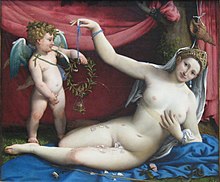Epithalamium
An epithalamium (
History
It was originally among the
Development as a literary form



In the hands of the poets the epithalamium was developed into a special literary form, and received considerable cultivation.
In later times Statius, Ausonius, Sidonius Apollinaris and Claudian are the authors of the best-known epithalamia in classical Latin; and they have been imitated by Julius Caesar Scaliger, Jacopo Sannazaro, and a whole host of modern Latin poets, with whom, indeed, the form was at one time in great favor.[2]
In the Italian
The names of
At the close of
E. E. Cummings also returns to the form in his poem Epithalamion, which appears in his 1923 book Tulips and Chimneys. E.E.Cummings' Epithalamion consists of three seven octave parts, and includes numerous references to ancient Greece.
The term is occasionally used beyond poetry, for example to describe
Music
Johann Wanning of Danzig is the composer of the first known musical epithalamium, a two-movement work for six voices, probably composed in the 1580s.
In Richard Wagner's Lohengrin, the "Bridal Chorus" (Treulich Geführt) of Act 3 is also called "Epithalamium" in several program notes: concert in London, 26 March 1855; concert in Paris, 25 January 1860; concert in Brussels, 24 March 1860.[citation needed]
The Epithalamium of Vindex is a popular aria from Néron opera by Anton Rubinstein (composed in 1875–76, premiered in 1879).
The English composer, Ralph Vaughan Williams (1872–1958) composed a choral work called Epithalamion consisting of 11 movements: The Prologue, Wake now, The Calling of the Bride, The Minstrels, Procession of the Bride, The Temple Gates, The Bell Ringers, The Lover's Song, The Minstrel's Song, Song of the Winged Loves, and Prayer to Juno. Set for baritone, chorus, flute, piano, and strings, the work is based on Spenser's poem of the same name. As he often did, Vaughan Williams incorporated the flavour of English folk songs into these songs.
The 20th-century French organist-composer (and successor in his post to Charles Tournemire and César Franck),
French composer
Norwegian composer Fartein Valen composed an orchestral piece called Epithalamion Op. 19 in 1933, celebrating the wedding of his nephew.
American
In 2006, British composer John McCabe was commissioned by John Sell to write a piano piece for the 70th birthday of his wife Jane Wade. Epithalamium was given its world premiere in 2007 by Malcolm Binns at the Wigmore Hall in London.
Painting
Epithalamia were also a painting genre popular in Italy during the Renaissance. These were nudes presented as wedding gifts, which were intended to wish newlyweds happiness and fertility.[11] Venus and Cupid was a common subject. Lorenzo Lotto's epithalamic painting notably portrayed Cupid as a puer mingens urinating on Venus, a gesture that symbolized fertility in Renaissance artwork.[12]
Although epithalamia existed only in poetic form during antiquity, during the Renaissance it was believed that presenting gifts of erotic paintings was an ancient Roman tradition.[13]
See also
References
- ^ Theophile J. Meek, Introduction and Exegesis to The Song of Songs, The Interpreters' Bible, 1956, volume V, p. 92
- ^ a b c d Chisholm 1911.
- ^ Angelo Paratico, Nuptialia – Per Nozze – Epithalamia, Gingko Edizioni blog (10 December 2013)
- ^ Will David,Celebrating Married Love: The London Library Collection of Per Nozze, The London Library Blog (20 May 2015)
- ^ Giancarlo Ciaramelli & Giancarlo Malacarne, Nuptialia : Libretti di nozze nelle collezioni della Teresiana Archived 2014-03-25 at the Wayback Machine, Biblioteca Teresiana di Mantova.
- ^ Duke University, Mazzoni "Per Nozze" Pamphlets Archived 2018-03-06 at the Wayback Machine
- ISBN 1-57322-751-X
- ^ a b "I Fagiolini Amuse Bouche". I Fagiolini Amuse Bouche. Retrieved 2020-02-15.
- ^ "BBC Radio Scotland - Classics Unwrapped, 26/07/2015". Retrieved 2020-02-15.
- ^ "Klavier Wind Project". Klavier-records.com. Archived from the original on 2014-02-07. Retrieved 2014-06-04.
- ^ Andreas Prater, Venus and her Mirror (Munich, Berlin, London, New York: Prestel 2002): 29
- .
- ^ Vincenzo Catari Imagini degli dei de gli antichi ca 1500.
Sources
- This article incorporates text from a publication now in the public domain: Chisholm, Hugh, ed. (1911). "Epithalamium". Encyclopædia Britannica. Vol. 9 (11th ed.). Cambridge University Press. p. 705.
External links
- Catullus' Epithalamion
- E.E. Cummings' Epithalamion
- Edmund Spenser's Epithalamion
- Dannie Abse's Epithalamion
